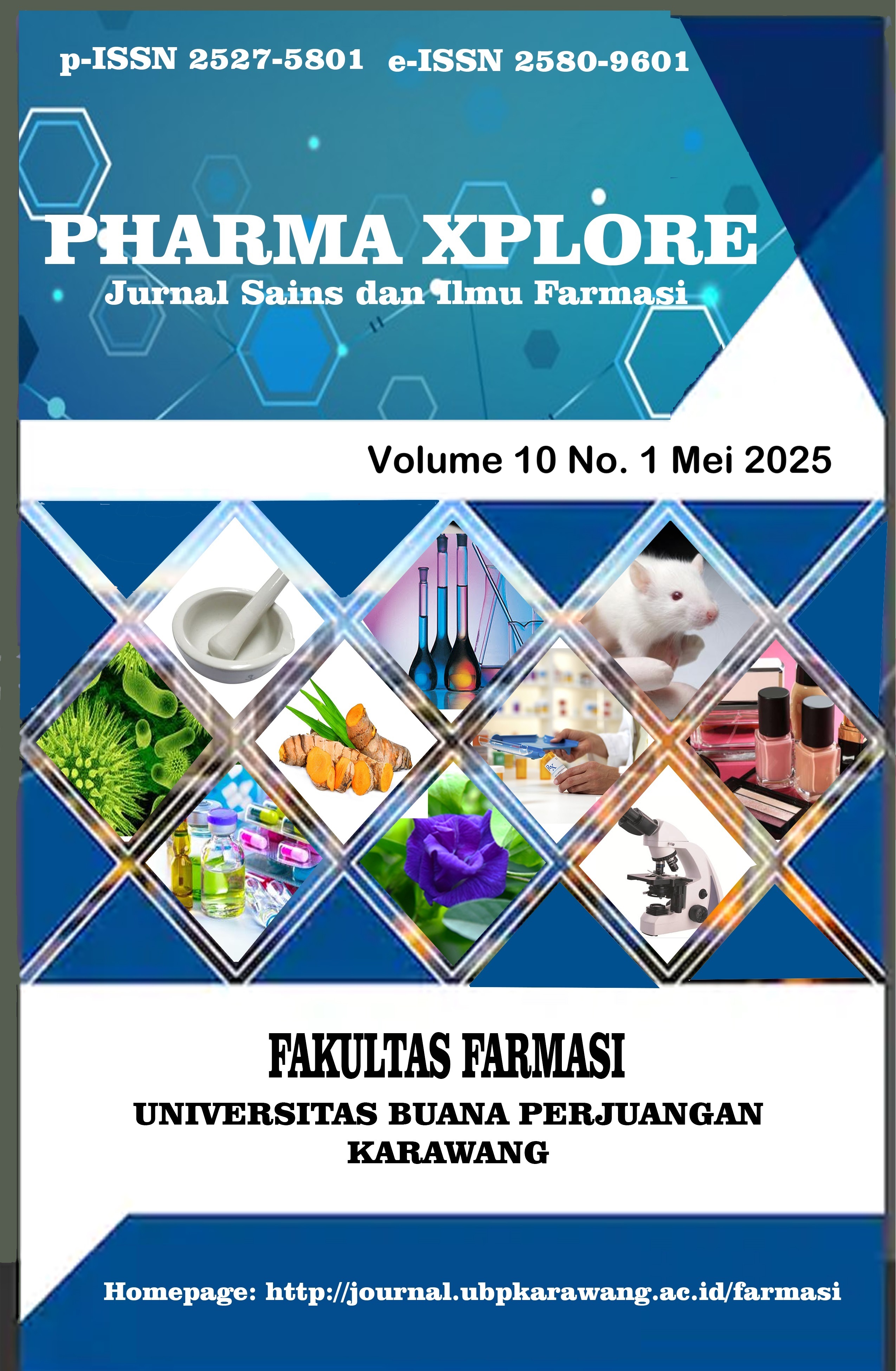UJI AKTIVITAS HIPNOTIK-SEDATIF EKSTRAK ETANOL 70% DAUN PATIKAN KEBO (Euphorbia hirta Linn) PADA MENCIT PUTIH JANTAN GALUR SWISS WEBSTER
DOI:
https://doi.org/10.36805/jpx.v10i1.10077Keywords:
Euphorbia hirta, Hypnotic-sedative, Patikan kebo, Phenobarbital, Rotarod, MiceAbstract
Sleep disorders such as insomnia are common health issues that significantly impact quality of life. Pharmacological therapies using hypnotic-sedative drugs often cause side effects, highlighting the need for alternative treatments derived from natural sources. One plant with potential hypnotic-sedative properties is patikan kebo (Euphorbia hirta L.). This study aimed to evaluate the hypnotic-sedative activity of 70% ethanol extract of patikan kebo leaves in male Swiss Webster mice. The extract was obtained through maceration using 70% ethanol and subsequently analyzed for phytochemical content and standardization. The hypnotic-sedative activity was tested in vivo using the rotarod test and by observing the onset and duration of sleep following phenobarbital induction. The phytochemical screening revealed the presence of flavonoids, alkaloids, tannins, quinones, and steroids/triterpenoids. A dose of 400 mg/kgBW demonstrated the most significant hypnotic-sedative activity, indicated by the highest number of falls (11.75 times), the fastest sleep onset (17.25 minutes), and the longest sleep duration (270 minutes) compared to the control group. In conclusion, the 70% ethanol extract of patikan kebo leaves shows promising potential as a natural hypnotic-sedative agent, with 400 mg/kgBW being the most effective dose.
References
Al Karaki, G., Hallit, S., Malaeb, D., Kheir, N., Sacre, H., Salameh, P., and Hallit, R. Prevalence and factors associated with insomnia among a representative sample of the Lebanese population: results of a cross-sectional study. Journal of Epidemiology and Global Health, 2020, 10(2), 124-130.
Badan Pengawas Obat dan Makanan Republik Indonesia (BPOM). 2014. Peraturan Kepala BPOM RI Nomor 12 Tahun 2014 tentang Persyaratan Mutu Obat Tradisional. Jakarta: BPOM.
Baldwin, D.S. Clinical management of withdrawal from benzodiazepine anxiolytic and hypnotic medications. Addiction, 2022, 117(5), 1472-1482.
Damanik, D.D.P. Ekstraksi katekin dari daun gambir (Uncaria gambir Roxb) dengan metode maserasi. Jurnal Teknik Kimia, 2014, 3(2), 10-15.
Direktorat Jenderal POM. 1989. Materia Medika Indonesia. Jilid V. Jakarta: Departemen Kesehatan Republik Indonesia. 549-553.
Ghosh, P., Ghosh, C., Das, S., Das, C., Mandal, S., and Chatterjee, S. Botanical description, phytochemical constituents and pharmacological properties of Euphorbia hirta Linn: A review. International Journal of Health Sciences and Research, 2019, 9(3), 273-280.
Glick, D.R., Abariga, S.A., Thomas, I., Shipper, A.G., Gunia, B.C., Grandner, M.A., et al. Economic impact of insufficient and disturbed sleep in the workplace. Pharmacoeconomics, 2023, 41(7), 771-785.
Kemboi, D., Peter, X., Langat, M., and Tembu, J. A review of the ethnomedicinal uses, biological activities, and triterpenoids of Euphorbia species. Molecules, 2020, 25(17), 4019.
Kementerian Kesehatan Republik Indonesia. 2011. Farmakope Herbal Indonesia. Jakarta: Kemenkes RI.
Lanhers, M.C., Fleurentin, J., Dorfman, P., Misslin, R., and Mortier, F. Neurophysiological effects of Euphorbia hirta L. (Euphorbiaceae). Phytotherapy Research, 1996, 10(8), 670-676.
Lohvina, H., Sándor, M., and Wink, M. Effect of ethanol solvents on total phenolic content and antioxidant properties of seed extracts of fenugreek (Trigonella foenum-graecum L.) varieties and determination of phenolic composition by HPLC-ESI-MS. Diversity, 2021, 14(1), 1-21.
Merrill, R.M. Mental health conditions according to stress and sleep disorders. International Journal of Environmental Research and Public Health, 2022, 19(13), 7957.
Motti, R., and de Falco B. Traditional herbal remedies used for managing anxiety and insomnia in Italy: An ethnopharmacological overview. Horticulturae, 2021, 7(12), 523.
Nurdin, M.A., Arsin, A.A., dan Thaha, R.M. Kualitas hidup penderita insomnia pada mahasiswa. Jurnal Media Kesehatan Masyarakat Indonesia, 2018, 14(2), 128-138.
Obi, B.C., Igweze, Z., Nwaogu, V., Ben, C., and Akunne, T.C. Studies on the anticonvulsant and sedative effects of Jatropha curcas (Euphorbiaceae) and Phragmanthera capitata (Loranthaceae) in mice. Drug Discoveries and Therapeutics, 2019, 13, 95-102.
Ríos, J.L., Schinella, G.R., and Moragrega, I. Phenolics as GABAA receptor ligands: An updated review. Molecules, 2022, 27(6), 1770.
Tzanova, M., Atanasov, V., Yaneva, Z., Ivanova, D., and Dinev, T. Selectivity of current extraction techniques for flavonoids from plant materials. Processes, 2020, 8(10), 1222.
Zulkarnain, Z., Muthiadin, C., Nur, F., dan Sijid A. Potensi kandungan senyawa ekstraksi daun patikan kebo (Euphorbia hirta L.) sebagai kandidat antibiotik alami. Jurnal Teknosains, 2021, 15(2), 190-196.












